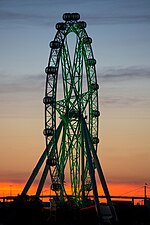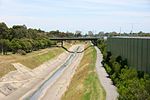West Melbourne, Victoria

West Melbourne is an inner-city suburb in Melbourne, Victoria, Australia, 2 km (1.2 mi) north-west of the Melbourne central business district, located within the City of Melbourne local government area. West Melbourne recorded a population of 8,025 at the 2021 census.Located adjacent to the CBD, West Melbourne is bounded by Victoria Street and the Sunbury/Werribee railway lines in the north, Footscray Road, the Moonee Ponds Creek; and by La Trobe Street in the south. Peel Street and the Flagstaff Gardens help form the eastern boundary, with the western boundary defined by the Maribyrnong River and Coode Island. Being originally largely an industrial area, a significant portion of West Melbourne is occupied by the Port of Melbourne, the Dynon Railway Yards and the Melbourne Markets. These include the Wholesale Fruit and Vegetable and Fish Markets, as well as the National Flower Centre. It also contains an increasing number of residential and commercial properties, consisting of a mixture of Victorian single and double storey terrace houses and converted warehouses at the north-west corner of the Melbourne CBD. It is also adjacent to the Queen Victoria Market, located on the east of Peel Street and to the south of Victoria Street.
Excerpt from the Wikipedia article West Melbourne, Victoria (License: CC BY-SA 3.0, Authors, Images).West Melbourne, Victoria
Footscray Road Offramp, Melbourne West Melbourne
Geographical coordinates (GPS) Address Nearby Places Show on map
Geographical coordinates (GPS)
| Latitude | Longitude |
|---|---|
| N -37.808 ° | E 144.927 ° |
Address
Footscray Road Offramp
Footscray Road Offramp
3003 Melbourne, West Melbourne
Victoria, Australia
Open on Google Maps








